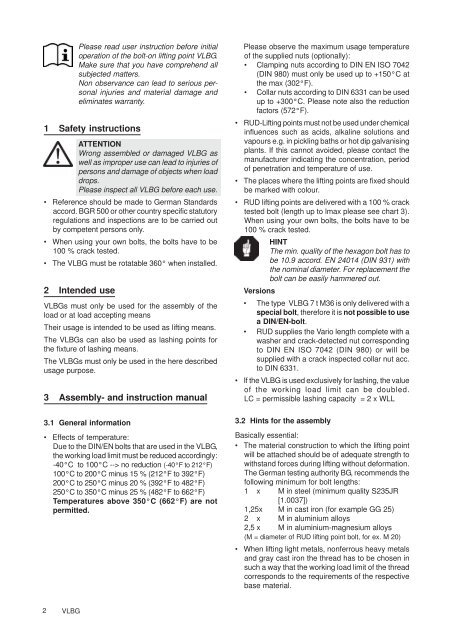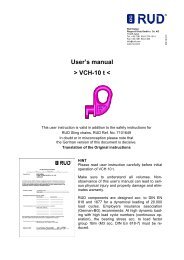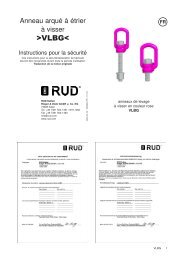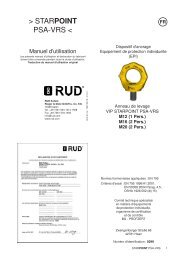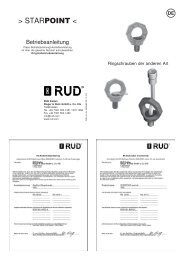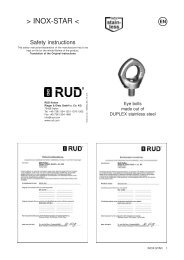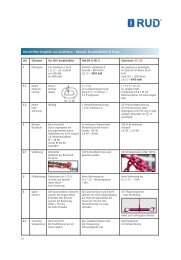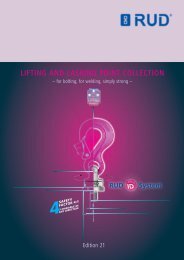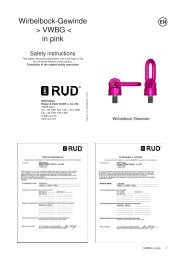VLBG< - RUD
VLBG< - RUD
VLBG< - RUD
Create successful ePaper yourself
Turn your PDF publications into a flip-book with our unique Google optimized e-Paper software.
Please read user instruction before initial<br />
operation of the bolt-on lifting point VLBG.<br />
Make sure that you have comprehend all<br />
subjected matters.<br />
Non observance can lead to serious personal<br />
injuries and material damage and<br />
eliminates warranty.<br />
1 Safety instructions<br />
ATTENTION<br />
Wrong assembled or damaged VLBG as<br />
well as improper use can lead to injuries of<br />
persons and damage of objects when load<br />
drops.<br />
Please inspect all VLBG before each use.<br />
• Reference should be made to German Standards<br />
accord. BGR 500 or other country specific statutory<br />
regulations and inspections are to be carried out<br />
by competent persons only.<br />
• When using your own bolts, the bolts have to be<br />
100 % crack tested.<br />
• The VLBG must be rotatable 360° when installed.<br />
2 Intended use<br />
VLBGs must only be used for the assembly of the<br />
load or at load accepting means<br />
Their usage is intended to be used as lifting means.<br />
The VLBGs can also be used as lashing points for<br />
the fixture of lashing means.<br />
The VLBGs must only be used in the here described<br />
usage purpose.<br />
3 Assembly- and instruction manual<br />
3.1 General information<br />
• Effects of temperature:<br />
Due to the DIN/EN bolts that are used in the VLBG,<br />
the working load limit must be reduced accordingly:<br />
-40°C to 100°C --> no reduction (-40°F to 212°F)<br />
100°C to 200°C minus 15 % (212°F to 392°F)<br />
200°C to 250°C minus 20 % (392°F to 482°F)<br />
250°C to 350°C minus 25 % (482°F to 662°F)<br />
Temperatures above 350°C (662°F) are not<br />
permitted.<br />
Please observe the maximum usage temperature<br />
of the supplied nuts (optionally):<br />
• Clamping nuts according to DIN EN ISO 7042<br />
(DIN 980) must only be used up to +150°C at<br />
the max (302°F).<br />
• Collar nuts according to DIN 6331 can be used<br />
up to +300°C. Please note also the reduction<br />
factors (572°F).<br />
• <strong>RUD</strong>-Lifting points must not be used under chemical<br />
influences such as acids, alkaline solutions and<br />
vapours e.g. in pickling baths or hot dip galvanising<br />
plants. If this cannot avoided, please contact the<br />
manufacturer indicating the concentration, period<br />
of penetration and temperature of use.<br />
• The places where the lifting points are fixed should<br />
be marked with colour.<br />
• <strong>RUD</strong> lifting points are delivered with a 100 % crack<br />
tested bolt (length up to lmax please see chart 3).<br />
When using your own bolts, the bolts have to be<br />
100 % crack tested.<br />
Versions<br />
HINT<br />
The min. quality of the hexagon bolt has to<br />
be 10.9 accord. EN 24014 (DIN 931) with<br />
the nominal diameter. For replacement the<br />
bolt can be easily hammered out.<br />
• The type VLBG 7 t M36 is only delivered with a<br />
special bolt, therefore it is not possible to use<br />
a DIN/EN-bolt.<br />
• <strong>RUD</strong> supplies the Vario length complete with a<br />
washer and crack-detected nut corresponding<br />
to DIN EN ISO 7042 (DIN 980) or will be<br />
supplied with a crack inspected collar nut acc.<br />
to DIN 6331.<br />
• If the VLBG is used exclusively for lashing, the value<br />
of the working load limit can be doubled.<br />
LC = permissible lashing capacity = 2 x WLL<br />
3.2 Hints for the assembly<br />
Basically essential:<br />
• The material construction to which the lifting point<br />
will be attached should be of adequate strength to<br />
withstand forces during lifting without deformation.<br />
The German testing authority BG, recommends the<br />
following minimum for bolt lengths:<br />
1 x M in steel (minimum quality S235JR<br />
[1.0037])<br />
1,25x M in cast iron (for example GG 25)<br />
2 x M in aluminium alloys<br />
2,5 x M in aluminium-magnesium alloys<br />
(M = diameter of <strong>RUD</strong> lifting point bolt, for ex. M 20)<br />
• When lifting light metals, nonferrous heavy metals<br />
and gray cast iron the thread has to be chosen in<br />
such a way that the working load limit of the thread<br />
corresponds to the requirements of the respective<br />
base material.<br />
2 VLBG


